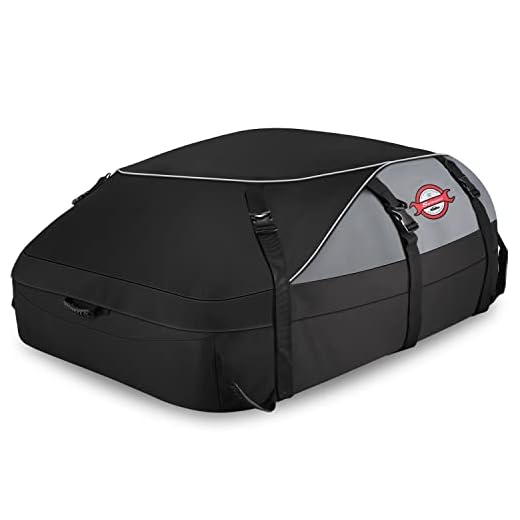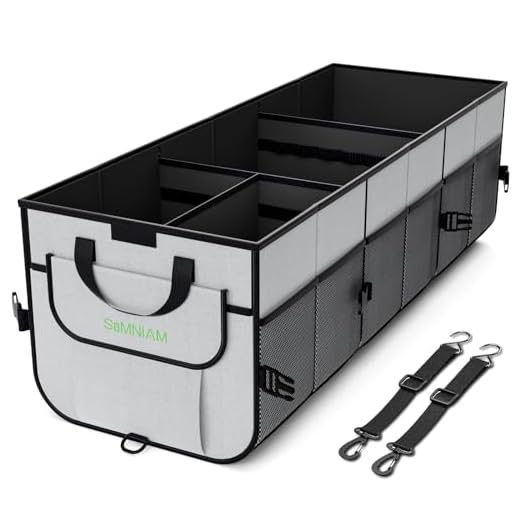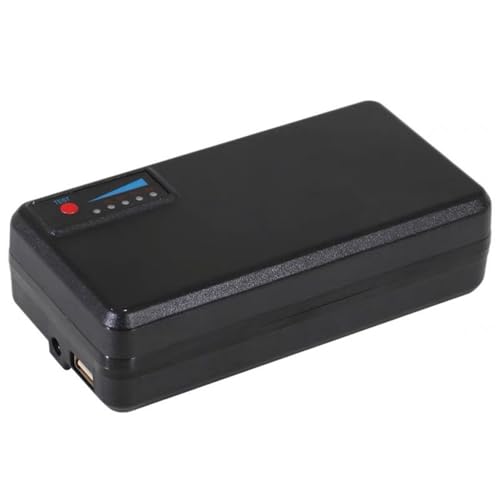


Recommendation: Load up to four full-size suitcases inside the cabin and boot with rear seats upright; to carry five or six medium suitcases fold the rear bench and add a roof box or a rear-mounted carrier. Keep the total payload (passengers + baggage) within the vehicle’s payload rating – typically 350–550 kg for compact and midsize models – and respect the stated roof load and tow-bar carrier limits.
Measure bag dimensions before departure: typical checked suitcase = 75 × 48 × 30 cm (~80–110 L), medium suitcase = 65 × 44 × 27 cm (~60–80 L), carry-on = 55 × 40 × 23 cm (~35–40 L). Practical packing layout: two large suitcases flat on the boot floor, two upright behind them, and smaller items in gaps or under seats. With seats folded, orient cases longitudinally to maximize space.
Weight management: Read the VIN/placard for GVWR and curb weight, then calculate payload = GVWR − curb weight. Example: GVWR 2100 kg minus curb 1600 kg yields 500 kg payload; if four adults total 320 kg, available luggage allowance ≈180 kg. Keep roof load typically ≤75 kg and hitch-carrier loads within the carrier’s rated mass (often 50–100 kg). Distribute heavy items low and close to the vehicle’s centerline to avoid axle overload and handling degradation.
Pre-trip checklist: weigh each bag, mark the heaviest two to place over or near the rear axle, secure external carriers with anti-theft bolts, inflate tyres to the manufacturer’s load pressure, and verify brake performance after loading. For repeated heavy use choose a rated roof box (300–450 L) or a certified hitch carrier rather than stacking items on the roof rails.
Five or additional suitcases: options with the operator
Recommendation: If you must carry five standard checked suitcases (62×42×27 cm; ≈70 L each), reserve a minivan/MPV or small cargo van and require the operator to confirm usable cargo volume – plan for at least 500–700 L of stowage or request a roof box or trailer as a guaranteed solution.
Vehicle capacity benchmarks
Usable luggage volumes and expected fit: hatchback 250–350 L (2–3 medium cases); compact sedan 350–450 L (3–4 cases); estate/wagon 500–650 L (4–5 cases); midsize SUV 450–700 L (4–6 cases depending on seat position); 7‑seater MPV/minivan with seats up 300–600 L, with seats folded 1,000–2,000 L; small cargo van 1,000–3,000 L (five cases easily accommodated).
Practical booking checklist
1) Specify exact number, external dimensions and approximate weight of each bag at reservation; request the vehicle model and declared trunk/cargo volume in writing.
2) Confirm extra‑baggage or oversized‑item fees before travel; many carriers charge per additional item (common range USD 5–30 per bag) or a flat rate for roof boxes/trailers – get the final price upfront.
3) Verify payload capacity versus total load: five bags at 23 kg each = ~115 kg; compare to vehicle payload (small cars ~400–500 kg; vans ~800–1,200 kg) when combining passenger mass plus baggage.
4) If interior space is marginal, request a roof box (adds ~300–450 L) or a tow hitch with a small trailer; ask about securing points and insurance for externally carried items.
5) At pickup, count and photograph all pieces placed into the vehicle and confirm the driver’s acknowledgment of the booked baggage count; if the supplied vehicle is undersized, insist on an immediate replacement or documented adjustment to the fare.
Vehicle models: trunk dimensions and interior capacity by model
Recommendation: choose Tourer estate to accommodate five full-size suitcases without folding seats; select VanPro for groups or bulky gear requiring a flat floor and maximum volume.
CityLite (compact hatchback) – Trunk: 320 L (rear seats up); floor length 90 cm; width between wheel arches 102 cm; height 55 cm. Seats: 5. Seats fold 60/40 to create 1,100 L. Payload: 500 kg. Packing note: fits 2 large checked suitcases + 1 cabin bag, or 3 cabin-size rollers if arranged vertically; remove parcel shelf to gain ~10–15 cm usable height.
Commuter (sedan) – Trunk: 450 L; usable depth 100 cm; width 110 cm; opening height 55 cm. Seats: 5; 40/20/40 pass-through increases usable length to 1,200 L. Payload: 520 kg. Packing note: fits 3 large checked suitcases or 4 cabin bags; for longer items use centre pass-through.
Tourer (estate/wagon) – Trunk: 620 L; depth 120 cm; width 112 cm; height 78 cm. Seats fold fully flat to 1,700 L. Roof rails standard. Payload: 600 kg. Packing note: fits 5–6 large checked suitcases with seats up, or 8–10 cabin bags with seats folded; ideal for airport transfers without roof boxes.
SUVMax (mid-size SUV) – Trunk: 540 L (5-seat), depth 105 cm; width 105 cm; height 90 cm. Seats fold 40/20/40 to 1,650 L. Tow/roof load ratings allow adding a roof box (+300–500 L) if needed. Payload: 650 kg. Packing note: accommodates 4 large suitcases + 2 cabin bags; use roof box when rear-seat passengers remain and extra volume is required.
VanPro (compact van / MPV) – Cargo volume: 2,800 L with rear rows removed; floor length 200 cm; width 130 cm; interior height 140 cm. Configurable seating for 2–9. Payload: 900 kg. Packing note: fits 8–10 large checked suitcases in cargo mode or many oversized items; secure loads to anchor points and distribute weight evenly to stay within payload limits.
Practical tips: remove or stow parcel shelf and small items to gain height; fold rear seats in specified sequence to avoid seat-belt entanglement; verify vehicle payload and roof-load limits before adding roof storage; choose soft-sided bags when trunk height is constrained to squeeze extra units into tight spaces.
Luggage policy: allowed pieces and size limits per booking
Select a fare that explicitly includes the number of checked pieces you need; recommended minimum for a family or multi-suitcase reservation is two checked items per passenger (each up to 23 kg / 158 cm linear) plus one cabin bag 55×40×20 cm and one personal item.
Specific limits, add-on fees and weight thresholds vary by fare class and reservation type; confirm allowed piece count on your ticket and add paid extra pieces in advance to avoid higher airport surcharges. Measure each bag (length + width + height) for linear dimension and use a bathroom scale for weight accuracy before travel.
| Fare tier (example) | Included checked pieces | Max weight per checked piece | Max linear dimension (checked) | Carry-on allowance |
|---|---|---|---|---|
| Basic / Saver | 0–1 pieces (depends on route) | – (pay to add; typical 23 kg) | – | 1 small cabin item (40×30×15 cm) + personal item |
| Standard | 1–2 pieces | 23 kg | 158 cm (sum L+W+H) | 1 cabin bag 55×40×20 cm + personal item |
| Flex / Business | 2–3 pieces | 23–32 kg (fare-dependent) | 158–203 cm (oversize rules apply) | 1 cabin bag + personal item; some fares allow an extra cabin piece |
| Group / Special | Varies by contract | Contracted weights; check manifest | Contracted limits or airline standard | Set by group booking terms |
Overweight (24–32 kg) and oversized (over 158 cm linear) pieces typically incur fixed fees; items above 32 kg or exceptionally large items require cargo-class handling with much higher charges. Sports equipment, musical instruments and strollers often count as a checked piece unless an itemized exception is listed on the fare rules.
When adding extra pieces online, compare the advance add-on price with estimated airport fees; pre-purchased extras are usually cheaper. For split-family itineraries, allocate checked pieces across passengers on the same booking to stay within per-reservation limits.
For group shoots or coordinated trips, pack fragile gear into hard cases and include a compact rain cover or umbrella such as best umbrella for group photography to protect equipment during transfers.
How to measure and pack five-plus suitcases to fit in the service vehicle
Recommendation: measure the cargo opening width, opening height and usable depth in centimetres and target a continuous usable volume of at least 600–700 litres to accommodate five full‑size suitcases (example large suitcase: 75×50×30 cm → 112.5 L each).
How to measure: 1) Measure the rear opening width between trim panels; 2) measure opening height from sill to top of opening; 3) measure floor depth from sill to back of rear seats with seats in the expected position; 4) subtract wheel‑well intrusion volume (approx. 10–20% of floor width on many vehicles). Convert to volume: width × height × depth (cm) ÷ 1,000 = litres of rectangular box; realistic usable volume is ~80–90% of that figure because of irregular shapes.
Suitcase sizing and arithmetic: common suitcase volumes: carry‑on 40–50 L (55×35×20 cm), medium 70–90 L (65×45×25 cm), large 110–120 L (75×50×30 cm). Five large units → ~562.5 L; five medium units → ~400–450 L. If bags are soft‑sided, expect 15–30% compressibility; vacuum compression can reduce height by up to 35–40% for textiles but not for hard‑shell cases.
Packing configurations to test: A) Two flat on the floor (wheels up), three upright behind them; B) Three flat across the floor, two stacked on top with soft bags on top layer; C) Upright staggered: place wheels toward rear for profile slimming, alternate handle orientation to nest corners. Model the trunk as a 3D grid: plan placements by length×width×height blocks (cm) before loading.
Accessory and space‑saving tips: collapse telescoping handles and tuck into pockets; remove external garment boxes and detachable items; use compression bags for garments and shoes to free 10–30 L per bag. Use low‑profile moving blankets and cargo straps to stabilise stacks; a roof box (300–500 L typical) is a valid overflow option if roof rails and weight limits permit – check roof rated load and aerodynamic clearance.
On‑site checklist: 1) Measure trunk with loaded sample bag to confirm fit; 2) prioritise hard‑shell pieces on the bottom, soft items above; 3) secure loose items to prevent shifting; 4) verify rear visibility and mirror lines after loading; 5) if rear seat folding is available and acceptable, fold a section to create continuous depth rather than forcing awkward stacking.
Booking solutions for extra baggage: larger vehicles, roof options, and shuttle requests
Recommendation: Select a higher-capacity vehicle class or add a roof box at reservation; if carrying five or above checked suitcases, request an additional vehicle or shuttle and confirm equipment at least 48–72 hours prior to pickup.
Vehicle classes, cargo volumes and roof equipment
Choose by cargo volume, not just passenger count. Typical usable trunk volumes by class (approximate): estate/wagon 450–600 L, SUV 400–700 L, minivan/MPV 600–1,000 L, panel van/people-carrier 1,000–2,500 L. Roof boxes commonly available: 300–600 L capacity; recommended load ratings: 50–80 kg (always check vehicle roof load limit). If total suitcase volume exceeds estimated trunk capacity, combine trunk + roof box or upgrade to an MPV/van.
Estimate suitcase volumes before booking: carry-on 30–45 L, medium checked 70–90 L, large checked 110–140 L. Add 10% spare volume for awkward shapes. Example: five medium cases ≈ 5×80 L = 400 L; if trunk ≈ 450 L, roof box 300–420 L or an MPV will solve capacity shortfall.
How to request extra service during booking
Steps to secure space and gear:
1. Choose vehicle class – select “MPV/van” if listed when total volume estimate ≥ vehicle trunk volume.
2. Add roof equipment – select roof box or roof rack option and specify requested box size (e.g., 420 L) and expected gross load (kg).
3. Request shuttle/second vehicle – use the booking extras menu or contact support to add a second vehicle or shuttle run when pieces exceed combined trunk+roof capacity.
Suggested booking note (copy/paste): “Request: 5 checked suitcases (approx. 70–90 L each). Require roof box ~420 L and assistance loading; confirm roof load rating and availability 48–72 hours before pickup. If roof box unavailable, provide MPV/van or second vehicle.”
Typical fees (estimate): roof box hire $10–$30 per day, extra-piece surcharge $7–$20 per bag, shuttle/second-vehicle flat fee $20–$60. Ask for a written confirmation of fees at reservation time to avoid surprises.
At pickup, present the booking note to on-site staff; if roof box was rented, verify mounting hardware and weight distribution. When a second vehicle is provided, confirm passenger split and allocation of suitcases to minimize handling and turnaround time.
Safety and weight distribution tips when carrying five or additional suitcases with the provider’s vehicles
Place the three heaviest pieces low and centered over the rear axle line, then secure them with ratchet straps or a cargo net to reduce pitch and lateral shift.
Practical loading sequence
- Load order: heavy → medium → light. Heavy cases go deepest and lowest; light items on top or in cabin.
- Left/right balance: mirror image loading where possible (e.g., 22 kg on left + 22 kg on right) to keep roll inertia minimal.
- Fore/aft placement: position mass close to the axle rather than cantilevered past the bumper to avoid excessive rear sag and reduced steering feel.
- Stacking: limit stack height to avoid obstructing rear view and to keep center of gravity low; use soft bags between hard shells to fill gaps.
- Securing: use rated straps to fixed anchor points, compress loads against bulkhead or trunk lip to prevent movement under braking.
How to calculate safe payload and adjustments
- Find GVWR (gross vehicle weight rating) on the driver-door sticker.
- Obtain curb weight (empty vehicle) from owner manual or sticker.
- Payload = GVWR − curb weight. Example: GVWR 2,200 kg − curb 1,600 kg = payload 600 kg.
- Account for occupants and fuel first (e.g., four adults at 75 kg = 300 kg). Remaining payload = payload − occupants − fuel.
- Do not exceed roof load limit printed on roof rails/owner manual; typical roof-box limits are 50–75 kg. Add roof weight to total payload calculation.
- Tyres: increase inflation to the manufacturer’s “loaded” pressure spec (if available) or add ~3–5 psi above normal highway pressure; check pressures cold before driving.
- Braking and handling: expect increased stopping distance and reduced cornering speeds; reduce highway speed by about 10–20% from usual cruising pace and leave extra following distance.
- Suspension and lights: watch for rear sag that can misalign headlights and taillamps; if sag blocks lights, reconfigure load or avoid night driving until corrected.
- Roof loads: prefer a rigid roof box with an approved roof rack; soft bags require multiple internal anchor points and anti-slip mats. Always use rated tie-downs and check tension after 10–20 km.
- Hatch/trunk closure: ensure seals are not pinched and that the latch engages fully; if the hatch won’t close, redistribute or move some items inside the cabin rather than leaving it ajar.
- Spare and tools access: keep jack and spare accessible; do not bury emergency kit beneath stacks of bags.
- Visibility: maintain clear view through rear window; if view is blocked, fit wide-angle side mirrors and drive more cautiously.
Choose lightweight hard-shell or hybrid cases to reduce mass – see best luggage not made in china. For longer trips where laundering matters, consider durable fabrics and appliances at your destination; a reference: best front loading washing machine for hard water.
Fees, damage liability, and how to document excess-baggage arrangements
Pre-book an extra-baggage allowance and obtain a written addendum that lists per-item charges, liability caps, payment method, and the vehicle identifier (plate number) plus staff name; do not load additional suitcases without that signed document.
Typical surcharge structures to expect: per extra suitcase USD 10–50; single-vehicle surcharge for bulky loads USD 25–150; roof-rack or rooftop box fee USD 15–75; overweight charge USD 2–5 per kg above an agreed weight; airport/curbside handling fees USD 5–30. Specify currency in the agreement and whether tolls, parking or waiting-time will be added at actual cost or flat rate.
Common liability limits used by operators: item-level caps usually USD 200–1,000; total-trip caps often USD 500–2,000. High-value items (electronics, jewelry, camera gear) are frequently excluded unless declared and sometimes insured separately; request a declared-value endorsement for full cover and note any depreciation rules. Verify whether compensation is replacement cost, repair cost, or actual cash value.
Document every arrangement with this protocol: 1) Before loading – take timestamped, high-resolution photos of each suitcase, contents (if feasible), visible damage, and the empty cargo area; photograph serial numbers and purchase receipts for valuables. 2) Create an inventory listing item description, approximate weight, declared value, and condition notes. 3) Prepare a short written addendum showing booking reference, date/time, origin/destination, fee breakdown, liability cap per item and per booking, staff name and vehicle plate; obtain signatures from both parties and a printed or emailed copy. 4) If payment is cash, ask for an itemized receipt; if by card, keep the transaction record and confirmation email.
Claims and reporting rules to include explicitly in the addendum: reporting window (common windows are immediate on delivery or within 24–72 hours for damage, and within 7–14 days for loss), required evidence (signed inventory, photos, original receipts), and the claim submission address/email. Typical processing times range from 30 to 90 days; request a written timeline and escalation contact for unresolved claims.
Additional protective and administrative measures: list and remove irreplaceable items from checked bags, place high-value gear in carry items, affix tamper-evident tags with owner contact, label every bag with booking reference and phone, and request that staff note any pre-existing scuffs on the vehicle cargo area in the addendum. Keep duplicates of all documentation in cloud storage and forward the signed addendum to the operator’s official email immediately after signing.







